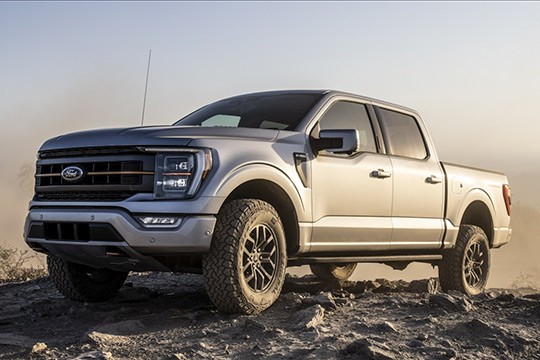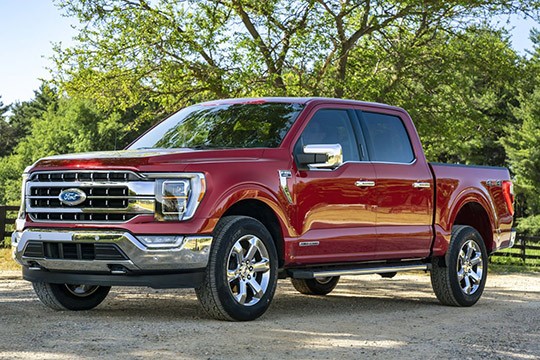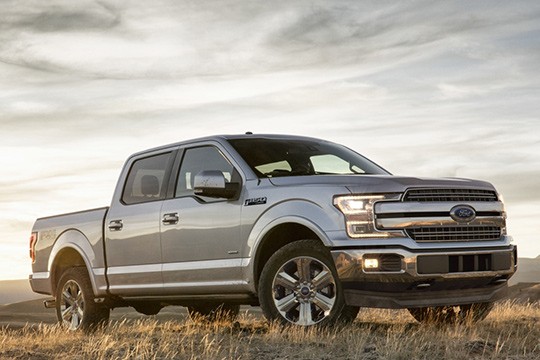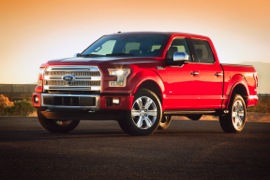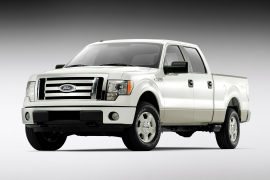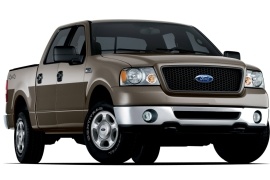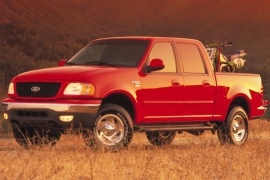FORD F-150 Super Crew Models/Series Timeline, Specifications & Photos
First production year: 2001
Engines: Gasoline, Diesel, Hybrid gasoline
Body style: Truck
Ford seems like it locked a hard off-road team and asked them to do a professional all-terrain pickup truck smart enough to be driven by newbies on expert trails.
Most of the off-road fans are customizing their trucks. Nobody wants to tackle a challenging trail with a showroom condition pickup-truck. Changing the tires is just for starters, but soon follows the suspension, skid plates, transmission, and so on. Ford engineers asked themselves if they cannot do that right from the start and do it better. So they took an F150 and upgraded it, and named it F150 Tremor.
The exterior looked mostly like a regular F150, but it was broader and taller. On the bodywork, there were some orange decals on the grille and the sides. As for why was the new beast taller and wider, that's a different story.
The interior was slightly reworked when compared to a regular loaded with options F150 Crew Cab. Active Orange punctuated an interior packed with Tremor detailing, including unique seat trim with superior stitching, materials, and finishes for the instrument panel, center console, and doors.
But the real upgrades were under the military-grade aluminum bodywork. The engineers installed a new suspension with higher ground clearance, with one inch at the front and 1.5" in the rear. There was one damper on the front side and two in the back. A set of bigger, 33" General Grabber all-terrain tires increased the ground clearance with an additional 1" all around. The transmission was reworked and featured a locking rear differential. A front locker was on the options list beside the standard LSD system. A complete set of skid plates protected the pickup-truck underbody as for towing capacity, which remained unchanged to 10.900 pounds (4944 kg).
The F150 was the most sold nameplate in the world since its introduction in 1948. In 2020, Ford introduced the 14th generation of the well-known pickup.
The world pandemic situation from 2020 forced the carmaker to launch one of its most essential products in an online event, even though it usually did major events with customers, buyers, media, and dealers. But the car raised the standards of what a vehicle of its type could be.
The exterior look might resemble the older generation, but it was completely new, with military-grade aluminum body panels. A new grille with wide slats was installed. On the wheel-arches, the designers installed plastic trims to protect the bodywork from mud and stones. In the back, the tailgate worked as a workbench fitted with anchor points for loads. Inside the bed, on the side, the engineers installed outlets for power tools. The electricity came from either a 150 kWh battery pack or a gas-powered generator.
The interior could have been fitted with features like in a business class cabin, with full-reclining front seats. Another interesting part was the tilting gear-selector that could have been folded and make room for the optional, arm-rest integrated, folding working desk. The infotainment system was Apple CarPlay and Android Auto wireless compatible. The car featured over-the-air updates. The instrument cluster was a configurable digital display.
Under the hood, Ford offered a wide choice of engines. It offered gasoline, diesel, and a hybrid version. The latter featured a 47 hp electric motor integrated into the automatic transmission.
Three years after introducing a new generation of the F150, Ford unveiled a new version in 2018 with smarter safety solutions that complemented the tough construction.
Ford F150 was the most sold nameplate in the world for more than 70 years. The American car-maker tried hard to stay ahead of its game and brought new challenges for its competitors. The 2018 F150 Super Crew was another example of how Ford could build a strong vehicle and make it even tougher.
In order to build a lighter vehicle, Ford changed the steel body panels with aluminum ones. But to make them stronger, it used military-grade ones. The chassis was made out of high-strength steel boxed ladder frame. Due to that, the payload could have been increased, and it could pull heavier loads. The two-slats chromed grille with a mesh behind transformed the front part of the F150 Super-Crew into a stylish pickup, ready for a family trip just about anytime and anywhere. The flared wheel arches and the big, AT-tires were just another proof that the vehicle was fit for any job.
Inside, the car-maker fitted the car with better materials and comfortable seats for up to five occupants. A prominent center console with an adequately large storage compartment separated the front seas. The super-crew version was fitted with rear doors and a more extended cabin, so there was no need to worry about the rear passengers' legroom.
Under the hood, the F150 Super Crew was offered with a choice of three gasoline engines, ranged from the 2.7-liter turbocharged engine to a 5.0-liter naturally aspirated V8. The base unit was a 3.3-liter unit paired to a 6-speed automatic transmission, while the other version was mated to a standard 10-speed auto.
The best selling vehicle in the U.S., after 34 years in a row is the Ford F150. In the half-ton pickup, the F-150 is the all-around vehicle, from the hard-working truck to the car for a date.
The secret of the F-150's success is Ford's refusal to rest on its glory. In 2011, the company refreshed the F150's engine and transmission to include a twin-turbocharged V6. The half-ton truck received more improvements in interior comfort and off-road ability. For instance, the rear axle received a locking differential instead of the limited-slip type as it was used before. A new feature was added for the Hill Start Assist, which was offered as an option before but since 2012 it became standard. A new two-speed automatic 4x4 system was added from the Lariat trim levels and up.
The 2012 F-150 was offered in three body variants: regular cab, SuperCab, and SuperCrew. The SuperCrew offered a bench in the back wide enough for three adults. The outer heated seats offered more comfort in cold weather. On the back of the center console, the car-maker installed a 120 volts outlet. In the front, the line between work and comfort was blurry, with many features mostly met in a luxury car.
Between the dials on the instrument cluster, a new 4.2” display showed information for the on-board computer, fuel economy, range, average speed, or information about the 4x4 system, if fitted. There are 10 trim levels on the F-150, and apart from the base, XT model, Ford offers the SYNC infotainment system that supported iPod connectivity, Bluetooth connectivity with the mobile phone.
Ford introduced the twelfth generation of the F-150 pickup in 2008 as a 2009 model-year in 35 versions, and the SuperCrew was the most family-oriented of them all.
Despite the plunging economy during the world financial crisis, Ford pushed harder and launched a completely new model of its best-selling product, the F-150. While the SingleCab was the plain work truck, the SuperCrew was at the other end of the scale. At the front, it shared the same front fascia as the rest of the range, sporting either a three-slat chromed grille or a more stylish one with a mesh design, depending on the trim level. Its L-shaped headlights and the low-mounted fog lights in the bumper provided the much-needed road illumination during night driving. From its sides, the customers could choose between the black, unpainted door handles and mirrors or the body-colored ones for the upper trim levels.
Ford traded some loading space for cabin space. Thus, it could provide more legroom for the rear-seat passengers. Moreover, the rear bench could slide and flips up out of the way, leaving a 57.6 cu-ft (1,631 liters of space). That’s more than most of the compact-sized station wagons on the market from those years. A complete instrument cluster fitted with two large dials and four small gauges provided the necessary information for the driver. In addition, an LCD sat between the speedometer and tachometer, showing more data from the onboard computer.
Under the skin, the F-150 SuperCrew featured the same hydroformed chassis that impressed the IIHS inspectors when they crash-tested the pickup. Under the hood, Ford installed only V8 engines paired with a standard six-speed automatic gearbox.
Ford introduced the eleventh generation of the F-150 in 2004, and the Super Crew cab version was the one that transformed the workhorse pickup into a great family vehicle.
With a reputation to defend and considerable experience on the market, Ford considered that updating an old vehicle was not enough anymore. It had to come with something completely new, and that was the 2004 F-150. Thus, it could raise the bar and forced other pickup makers to try and keep up with the best-sold vehicle in the world.
Unlike the Regular or the Super-Cab versions, the Super Crew featured a cabin with four full-size doors. The dipped-down front side of the door-windows, like the Ford Super Duty series, was a unique design detail in the pickup market and allowed the carmaker to install the door-mirrors lower and enhanced the driver's visibility. Depending on the trim option, Ford offered the Super Crew with one or two-tone body-paint. In the back, Ford offered the Super Crew with a choice of 5.5' (1,676 mm) and 6.5' (1,981 mm) bed option.
Inside, there was a car-like interior, with a wide center stalk and silver trims. The wide center console featured cup-holders good enough for a big-gulp pop can. Ford re-arranged the dials on the instrument cluster and placed the small gauges for fuel-level, coolant-temperature, ammeter, and oil pressure between the big speedometer and tachometer. In the back, it offered a wide bench for three, with a flat floor.
Under the hood, Ford installed a choice of three gasoline engines that provided between 231 hp and 300 hp. It was available with rear- or all-wheel-drive.
The F150 reached its tenth generation in 1997, but the blue-oval brand's marketing department found a niche on the market and introduced a longer version in 2001: the Super Crew.
By 2001, Ford F-Series was already the most produced nameplate in the world. After millions of units produced and different evolution in its lineup, Ford F-150 came on the market with a new approach, which allowed it to offer roomier interiors and still carry heavy loads, not to mention towing capabilities.
The 2001 F-150 didn't look as rough as some other pickups on the market. Its rounded edges and smoother design for the headlights might sound like a softening for the rugged pickup. The Super Crew version featured four full-size doors. Ford already had a four-door version, the SuperCab, but with rear-hinged rear doors. The Super Crew had regular doors. In the back, the bed was big enough for most of the loads and, if there was a need for something more, the car could tow up to 8000 lbs (3628 kg) in a 2WD version.
Since the Super Crew was designed to be as useful as a utility vehicle as a family vehicle able to tow the boat to a lake in the mountains, the interior had to be comfortable enough. There was plenty of room for five passengers. The wide cabin allowed three adults to sit in the back comfortably.
Under the hood, Ford installed some of the powerplants offered on the other versions. There were two V8 options: a 4.6-liter and a 5.4-liter unit. The Super Crew was offered as 2WD or 4WD, but only with an automatic transmission.
